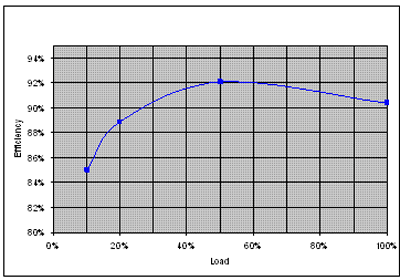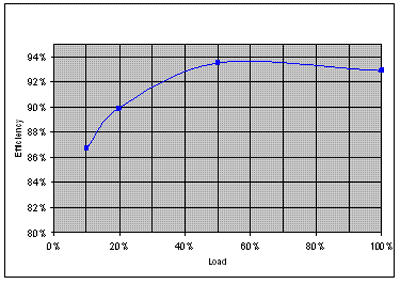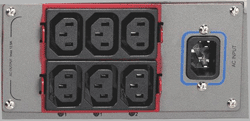Increase efficiencies with HV supplies, 208-V UPSs
Understanding existing methods and systems can bring immediate efficiencies and money to the bottom line
BY HERVÉ TARDY
Eaton, Cleveland, OH
http://www.eaton.com
Maximizing energy efficiencies is rapidly becoming significant in saving costs and reducing an organization’s carbon footprint. Using state-of-the art power supplies and 208-V UPSs will drive higher efficiencies and uptime, power conservation, and more meaningful green initiatives. The selection of the proper input voltage will have a direct impact on power supply output capacity, power conversion efficiency, power supply thermal operation and reliability all of which affect the bottom line.
Saving energy with high-voltage
When the United States rolled out the first electrical grid, light bulb filaments were very fragile and burned out fast on 208-V lines. Dropping the voltage to 110/120 V increased filament life thus, 120 V became the standard in the U.S. By the time Europe and the rest of the world built out their power grids, advances in filament design had largely eliminated the high-voltage problem, hence the 230/250-V power systems across most of the rest of the globe.
It’s important to note that each time voltage is stepped down, a transformer is used, and power is lost. The loss may be as little as 1% or 2% per transformer, but over time, the penalty for transformer use adds up. By switching to a 208-V system, you need one less transformer in the chain, thereby reducing wasted energy.
Moreover, 208-V systems are safer and more efficient as more current is required to push the same wattage through 120 V as through 208 V, increasing the risk of injury and losing additional power in transit.
High-efficiency power supplies
Most end users don’t pay too much attention to the internal power supply unit (PSU) in a computer server. However, it pays to consider power supplies that are highly efficient. Today’s major server manufacturers now equip their boxes with auto-sensing input circuitry that automatically adjusts to the applied input voltage. The only exceptions are those devices that are defined as high-voltage operation only. (Make sure to always review a device’s input specifications prior to connecting them to the power distribution system.)
High-voltage vs. low-voltage input power
At first thought, high-voltage input power seems counter-intuitive when thinking about energy savings. However, in the real world, power supplies operate more efficiently when operating at high-voltage. The typical server switch-mode power supply has an efficiency rating between 65% and 80%. Some special-purpose products can reach 90% efficiency. Operating at low-voltage causes the power supply to operate at the lower end of this range.
When operating at 208 V and depending on load level, a 1.0% to 2.0% difference in efficiency can be experienced for a 1,000-W power supply (refer to Figs. 1, 2, and 3). When one adds the loss in the power distribution transformer (PDU) to get to the 120 V, there is an additional 1.5% to 2.0% savings. Include cooling efficiencies and the savings add up to between 4% and 8%, which translates to about $70 per power supply. When multiplied by the number of power supplies in the server rack, the savings are worth making the switch to 208 V especially when expanding or moving into a new location.
Power supply thermal operation is also affected by the choice of input voltage. Input components run hotter when operating with low-voltage input power. This is caused by the almost double input current. The formula for heat generated in a component is I2 x R, where I is the input current and R is the resistance of the component. Therefore, if the input current is doubled, the heat generated in any given component is going to be four times higher. The life of a component is significantly shortened when it continuously runs at higher temperatures. Therefore, there is an overall impact on the life expectancy of the supply.

Fig. 1. Vendor A: 1,000-W PSU operating at 115 V.

Fig. 2. Vendor A: 1,000-W PSU operating at 230 V.

Fig. 3. Vendor A: 1,000-W PSU operating at 240 V.
Breaking tradition with 208 V/230-V power distribution
To satisfy global markets, virtually all IT equipment today is rated to work with input power voltages ranging from 100 to 240 Vac. The higher the voltage, the more efficiently the unit operates. For example, a Hewlett-Packard ProLiant DL380 Generation 5 server operates at 82% efficiency at 120 V, 84% efficiency at 208 V and 85% at 230 V.
Many users have not made this switch yet simply because they’re not aware of the energy savings and how to go about making the change to high-voltage. Good news it’s very simple. Users can gain this incremental advantage just by changing the input power (and the power distribution unit in the rack). In some cases, it may be necessary to change a switch setting on the device. Unfortunately, most equipment is automatically set to operate off lower-voltage power sacrificing efficiency for tradition. In addition, if a facility does not have 208-V service at the server rack, an electrician will need to pull wire and add receptacles.
Getting past the first impression
One of the key reasons why customers in the U.S. have been reluctant to switch to high voltage is a simple, practical issue: high voltage UPSs are typically fitted with IEC outlets (or even inlets) and customers do not know how to connect them to IT equipment with a traditional NEMA plug. This again is very simple (see Fig. 4): All IT power supplies come with a detachable input cord with a NEMA plug on the one side and an IEC plug on the other side. You just need to detach this input cord from the server, for instance, and connect it to the input of the UPS, then use the various IEC jumper cables that come with the UPS to connect your IT equipment. These IEC cables are fully UL-listed and are the standard method of connection in large mission-critical data centers in the U.S.

Fig. 4. Remove the input cable from your IT equipment and simply plug it into the input IEC receptacle of the UPS (blue circle). Use the various jumper cables provided with the UPS to connect the IEC outlets of the UPS (red) with the various IT devices you want to protect.
Further increase savings by using high-efficiency UPSs
Advances in UPS technologies have greatly improved the efficiency of UPS systems. In the 1980s, a state-of-the-art UPS was 75% to 80% efficient at best. With the advent of faster switching devices in the 1990s, efficiency jumped to 85% to 90%, and later to 90% to 94%.
Even higher efficiency is now possible. With input voltage of 208 or 400 Vac, some modular UPSs can operate at an industry-leading 97% efficiency in normal operation. Even at
Even small increases in UPS efficiency can quickly translate into tens of thousands of dollars. For example, assuming a utility rate of 10 cents/kWh, a 60 kW n+1 redundant configuration would save more than $30,000 in five years. High UPS efficiency also extends battery runtimes and produces cooler operating conditions (see Fig. 5).

Fig. 5. Efficiency savings with BladeUPS.
Should users still need some low voltage 120-V service for legacy IT equipment that cannot use high voltage, modular step-down transformers in 5-kVA increments can do the trick. No need to go for a fully-rated transformer when low voltage is only needed for 25% of the available power.
While there are new tools and technologies being introduced everyday to save energy, understanding existing methods and systems can bring immediate efficiencies and money to the bottom line — oftentimes without an additional investment. Using state-of-the art power supplies and 208-V UPSs will drive higher efficiencies and uptime, power conservation and meaningful green initiatives.
Advertisement
Learn more about Eaton, Power Quality





